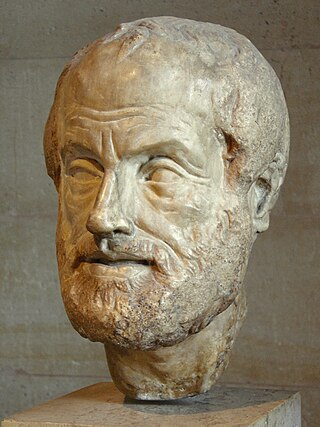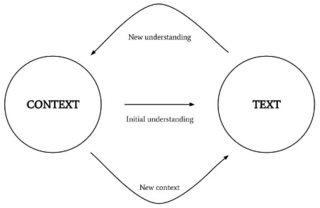Interpretation may refer to:
Interpretation may refer to:
An axiom, postulate, or assumption is a statement that is taken to be true, to serve as a premise or starting point for further reasoning and arguments. The word comes from the Ancient Greek word ἀξίωμα (axíōma), meaning 'that which is thought worthy or fit' or 'that which commends itself as evident'.
The Copenhagen interpretation is a collection of views about the meaning of quantum mechanics, principally attributed to Niels Bohr and Werner Heisenberg. It is one of the oldest of numerous proposed interpretations of quantum mechanics, as features of it date to the development of quantum mechanics during 1925–1927, and it remains one of the most commonly taught.
First-order logic—also known as predicate logic, quantificational logic, and first-order predicate calculus—is a collection of formal systems used in mathematics, philosophy, linguistics, and computer science. First-order logic uses quantified variables over non-logical objects, and allows the use of sentences that contain variables, so that rather than propositions such as "Socrates is a man", one can have expressions in the form "there exists x such that x is Socrates and x is a man", where "there exists" is a quantifier, while x is a variable. This distinguishes it from propositional logic, which does not use quantifiers or relations; in this sense, propositional logic is the foundation of first-order logic.

Probability in science of an event is a number that indicates how likely the event is to occur. It is expressed as a number in the range from 0 and 1, or, using percentage notation, in the range from 0% to 100%. The more likely it is that the event will occur, the higher its probability. The probability of an impossible event is 0; that of an event that is certain to occur is 1. The probabilities of two complementary events A and B – either A occurs or B occurs – add up to 1. A simple example is the tossing of a fair (unbiased) coin. If a coin is fair, the two possible outcomes are equally likely; since these two outcomes are complementary and the probability of "heads" equals the probability of "tails", the probability of each of the two outcomes equals 1/2.

A sign is an object, quality, event, or entity whose presence or occurrence indicates the probable presence or occurrence of something else. A natural sign bears a causal relation to its object—for instance, thunder is a sign of storm, or medical symptoms a sign of disease. A conventional sign signifies by agreement, as a full stop signifies the end of a sentence; similarly the words and expressions of a language, as well as bodily gestures, can be regarded as signs, expressing particular meanings. The physical objects most commonly referred to as signs generally inform or instruct using written text, symbols, pictures or a combination of these.
A theory is a rational type of abstract thinking about a phenomenon, or the results of such thinking. The process of contemplative and rational thinking is often associated with such processes as observational study or research. Theories may be scientific, belong to a non-scientific discipline, or no discipline at all. Depending on the context, a theory's assertions might, for example, include generalized explanations of how nature works. The word has its roots in ancient Greek, but in modern use it has taken on several related meanings.
An interpretation of quantum mechanics is an attempt to explain how the mathematical theory of quantum mechanics might correspond to experienced reality. Although quantum mechanics has held up to rigorous and extremely precise tests in an extraordinarily broad range of experiments, there exist a number of contending schools of thought over their interpretation. These views on interpretation differ on such fundamental questions as whether quantum mechanics is deterministic or stochastic, local or non-local, which elements of quantum mechanics can be considered real, and what the nature of measurement is, among other matters.

Hermeneutics is the theory and methodology of interpretation, especially the interpretation of biblical texts, wisdom literature, as well as philosophical texts. As necessary, hermeneutics may include the art of understanding and communication.
Metalogic is the study of the metatheory of logic. Whereas logic studies how logical systems can be used to construct valid and sound arguments, metalogic studies the properties of logical systems. Logic concerns the truths that may be derived using a logical system; metalogic concerns the truths that may be derived about the languages and systems that are used to express truths.
In linguistics and semiotics, a notation is a system of graphics or symbols, characters and abbreviated expressions, used in artistic and scientific disciplines to represent technical facts and quantities by convention. Therefore, a notation is a collection of related symbols that are each given an arbitrary meaning, created to facilitate structured communication within a domain knowledge or field of study.
In semiotics, a sign is anything that communicates a meaning that is not the sign itself to the interpreter of the sign. The meaning can be intentional, as when a word is uttered with a specific meaning, or unintentional, as when a symptom is taken as a sign of a particular medical condition. Signs can communicate through any of the senses, visual, auditory, tactile, olfactory, or taste.
Biblical hermeneutics is the study of the principles of interpretation concerning the books of the Bible. It is part of the broader field of hermeneutics, which involves the study of principles of interpretation, both theory and methodology, for all forms of communication, nonverbal and verbal.

Representation is the use of signs that stand in for and take the place of something else. It is through representation that people organize the world and reality through the act of naming its elements. Signs are arranged in order to form semantic constructions and express relations.
Logic is the formal science of using reason and is considered a branch of both philosophy and mathematics and to a lesser extent computer science. Logic investigates and classifies the structure of statements and arguments, both through the study of formal systems of inference and the study of arguments in natural language. The scope of logic can therefore be very large, ranging from core topics such as the study of fallacies and paradoxes, to specialized analyses of reasoning such as probability, correct reasoning, and arguments involving causality. One of the aims of logic is to identify the correct and incorrect inferences. Logicians study the criteria for the evaluation of arguments.

The hermeneutic circle describes the process of understanding a text hermeneutically. It refers to the idea that one's understanding of the text as a whole is established by reference to the individual parts and one's understanding of each individual part by reference to the whole. The circle is a metaphor for the procedure of transforming one's understanding of the part and the whole through iterative recontextualization.
An interpretation is an assignment of meaning to the symbols of a formal language. Many formal languages used in mathematics, logic, and theoretical computer science are defined in solely syntactic terms, and as such do not have any meaning until they are given some interpretation. The general study of interpretations of formal languages is called formal semantics.
A philosophical interpretation is the assignment of meanings to various concepts, symbols, or objects under consideration. Two broad types of interpretation can be distinguished: interpretations of physical objects, and interpretations of concepts.
The Interpretive Theory of Translation (ITT) is a concept from the field of Translation Studies. It was established in the 1970s by Danica Seleskovitch, a French translation scholar and former Head of the Paris School of Interpreters and Translators. A conference interpreter herself, Seleskovitch challenged the view prevailing at the time that translation was no more than a linguistic activity, one language being merely transcoded into another. She described translation as a triangular process: from one language to sense and from sense to the other language. She coined the name Interpretive Theory of Translation and, even before Translation Studies became a field in its own right, introduced the process of translation into the vast area of cognitive research. In order to verify the first observations made as a practitioner, Seleskovitch went on to write a doctoral thesis. Soon, a handful of conference interpreters interested in research joined her at ESIT.